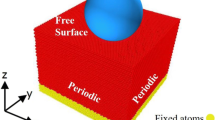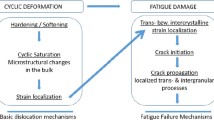Abstract
This research utilizes both single crystal and polycrystalline models to probe the fatigue crack propagation mechanism in pure silver via molecular dynamics (MD) simulations. A comprehensive validation approach at both micro and macro scales, incorporating transmission electron microscopy (TEM), electron backscatter diffraction (EBSD), and compact tension (CT) specimen fatigue testing, is developed to verify the reliability of simulation models and results. Simulation findings indicate that the initial crack orientation significantly influences crack propagation. As the crack advances within the crystal, two primary crack propagation mechanisms are discerned: (1) nano-voids appear at the crack tip, and the crack propagates by continuously aggregating with the nano-voids ahead; (2) the formation of Stair-rod dislocations and V-shape stacking faults due to dislocation reactions and slip band movements impedes crack propagation, accompanied by the dislocation reaction of Shockley partial dislocations (\(\tfrac{1}{6}\) <112>) generating Hirth dislocations (\(\tfrac{1}{6}\) <110>). The dislocation reaction is verified through the dislocation analysis of the crack tip area of the CT specimen after fatigue experiment by using TEM. In addition, the results of this study show that the angle between the direction of crack propagation and the grain boundary affects the fatigue crack propagation, e.g. when the angle is less than 60°, the crack rapidly propagates along the grain boundary. The orientation distribution function (ODF) results of EBSD can verify that the polycrystalline model containing 30 grains is a reliable model for the MD simulation of behavior of the crack tip of CT specimen. Lastly, the Paris law constants for pure silver are determined as m = 3.72 and lg C = − 10.77, providing a reference for the fatigue analysis and life prediction of silver components or silver soldering pots in engineering applications.

























Similar content being viewed by others
References
Aitken ZH, Sorkin V, Yu ZG, Chen S, Wu Z, Zhang Y-W (2021) Modified embedded-atom method potentials for the plasticity and fracture behaviors of unary fcc metals. Phys Rev B 103:094116. https://doi.org/10.1103/PhysRevB.103.094116
Ancona F, De Finis R, Palumbo D, Galietti U (2015) Crack growth monitoring in stainless steels by means of TSA technique. Procedia Eng 109:89–96. https://doi.org/10.1016/j.proeng.2015.06.212
Ancona F, Palumbo D, De Finis R, Demelio GP, Galietti U (2016) Automatic procedure for evaluating the Paris law of martensitic and austenitic stainless steels by means of thermal methods. Eng Fract Mech 163:206–219. https://doi.org/10.1016/j.engfracmech.2016.06.016
Arima T, Idemitsu K, Inagaki Y, Tsujita Y, Kinoshita M, Yakub E (2009) Evaluation of melting point of UO2 by molecular dynamics simulation. J Nucl Mater 389:149–154. https://doi.org/10.1016/j.jnucmat.2009.01.020
Bachmann F, Hielscher R, Schaeben H (2011) Grain detection from 2d and 3d EBSD data—specification of the MTEX algorithm. Ultramicroscopy 111:1720–1733. https://doi.org/10.1016/j.ultramic.2011.08.002
Carrascal I, Casado JA, Diego S, Lacalle R, Cicero S, Álvarez JA (2014) Determination of the Paris’ law constants by means of infrared thermographic techniques. Polym Testing 40:39–45. https://doi.org/10.1016/j.polymertesting.2014.08.005
Chauhan S, Pawar AK, Chattopadhyay J, Dutta BK (2016) Determination of fatigue properties using miniaturized specimens. Trans Indian Inst Met 69:609–615. https://doi.org/10.1007/s12666-015-0796-1
Chen X, **e Y, Huang Y (2023) Multi-scale simulations of the mechanical behaviors of the W-Cu joint interface with a diffusion layer. J Mol Model 29:247. https://doi.org/10.1007/s00894-023-05633-1
Cheng Z, Wang H, Liu G-R (2021) Fatigue crack propagation in carbon steel using RVE based model. Eng Fract Mech 258:108050. https://doi.org/10.1016/j.engfracmech.2021.108050
Daw MS, Baskes MI (1983) Semiempirical, quantum mechanical calculation of hydrogen embrittlement in metals. Phys Rev Lett 50:1285–1288. https://doi.org/10.1103/PhysRevLett.50.1285
De Castro JTP, De Albuquerque SD, De Menezes IFM, Meggiolaro MA, Martha LF (2016) A note on notch shape optimization to minimize stress concentration effects. Theoret Appl Fract Mech 84:72–85. https://doi.org/10.1016/j.tafmec.2016.03.005
Fu T, Peng X, Huang C, Weng S, Zhao Y, Wang Z et al (2017) Strain rate dependence of tension and compression behavior in nano-polycrystalline vanadium nitride. Ceram Int 43:11635–11641. https://doi.org/10.1016/j.ceramint.2017.05.342
Gao S, Wang H, Huang H, Kang R (2023a) Molecular simulation of the plastic deformation and crack formation in single grit grinding of 4H-SiC single crystal. Int J Mech Sci 247:108147. https://doi.org/10.1016/j.ijmecsci.2023.108147
Gao S, Lang H, Wang H, Guo X, Kang R (2023b) Atomic understanding of elastic-plastic deformation and crack evolution for single crystal AlN during nanoscratch. Ceram Int 49:35357–35367. https://doi.org/10.1016/j.ceramint.2023.08.209
Hamada S, Zhang K, Koyama M, Ueda M, Noguchi H (2020) Fatigue crack propagation modes: plastic deformation mode and damage accumulation mode. Int J Fract 222:111–122. https://doi.org/10.1007/s10704-020-00433-7
Hanlon T (2003) Grain size effects on the fatigue response of nanocrystalline metals. Scripta Mater 49:675–680. https://doi.org/10.1016/S1359-6462(03)00393-2
Honeycutt JD, Andersen HC (1987) Molecular dynamics study of melting and freezing of small Lennard-Jones clusters. J Phys Chem 91:4950–4963. https://doi.org/10.1021/j100303a014
Horstemeyer MF, Farkas D, Kim S, Tang T, Potirniche G (2010) Nanostructurally small cracks (NSC): a review on atomistic modeling of fatigue. Int J Fatigue 32:1473–1502. https://doi.org/10.1016/j.ijfatigue.2010.01.006
Hu Y, Wang Y, Yao Y (2023) Molecular dynamics on the sintering mechanism and mechanical feature of the silver nanoparticles at different temperatures. Mater Today Commun 34:105292. https://doi.org/10.1016/j.mtcomm.2022.105292
**fei Z, Jiaohui Y, Chang L, Zitong Y, Jiaxin H, Haoyang Y et al (2023) Dislocation behavior in initial stage of plastic deformation for CoCrNi medium entropy alloy. J Alloy Compd 943:169057. https://doi.org/10.1016/j.jallcom.2023.169057
Kim Y-M, Lee B-J, Baskes MI (2006) Modified embedded-atom method interatomic potentials for Ti and Zr. Phys Rev B 74:014101. https://doi.org/10.1103/PhysRevB.74.014101
Li Q, Chen W, Du J, Lu M, Wang Z, Huang Y (2022) Microstructure and coordination mechanism of interface of stainless steel/carbon steel cladding plate prepared by vacuum diffusion bonding. Mater Sci Eng, A 829:142178. https://doi.org/10.1016/j.msea.2021.142178
Lu M, Wang F, Zeng X, Chen W, Zhang J (2020) Cohesive zone modeling for crack propagation in polycrystalline NiTi alloys using molecular dynamics. Theoret Appl Fract Mech 105:102402. https://doi.org/10.1016/j.tafmec.2019.102402
Ma L, **ao S, Deng H, Hu W (2014) Molecular dynamics simulation of fatigue crack propagation in bcc iron under cyclic loading. Int J Fatigue 68:253–259. https://doi.org/10.1016/j.ijfatigue.2014.04.010
Machová A, Pokluda J, Uhnáková A, Hora P (2014) 3D atomistic studies of fatigue behaviour of edge crack (001) in bcc iron loaded in mode I and II. Int J Fatigue 66:11–19. https://doi.org/10.1016/j.ijfatigue.2014.03.001
Nishimura K, Miyazaki N (2004) Molecular dynamics simulation of crack growth under cyclic loading. Comput Mater Sci 31:269–278. https://doi.org/10.1016/j.commatsci.2004.03.009
Ouyang Y, Lou G, **e Y, Wang W, Liu Z (2022) Relating the orientation of graphene on Cu grains by Euler Angles. Surfaces and Interfaces 30:101837. https://doi.org/10.1016/j.surfin.2022.101837
Paul S, Schwen D, Short MP, Momeni K (2023) A modified embedded-atom method potential for a quaternary Fe–Cr–Si–Mo solid solution alloy. Materials 16:2825. https://doi.org/10.3390/ma16072825
Potirniche GP, Horstemeyer MF, Gullett PM, Jelinek B (2006) Atomistic modelling of fatigue crack growth and dislocation structuring in FCC crystals. Proc R Soc A 462:3707–3731. https://doi.org/10.1098/rspa.2006.1746
Pratap A, Kumar Katiyar N, Fan P, Goel S, Joshi SS (2024) Forest hardening and Hirth lock during grinding of copper evidenced by MD simulations. Manuf Lett 40:58–64. https://doi.org/10.1016/j.mfglet.2024.03.002
Sheng HW, Kramer MJ, Cadien A, Fujita T, Chen MW (2011) Highly optimized embedded-atom-method potentials for fourteen fcc metals. Phys Rev B 83:134118. https://doi.org/10.1103/PhysRevB.83.134118
Shioda R, Kariya Y, Mizumura N, Sasaki K (2017) Low-cycle fatigue life and fatigue crack propagation of sintered Ag nanoparticles. J Electron Mater 46:1155–1162. https://doi.org/10.1007/s11664-016-5068-2
Stepanova LV, Belova ON (2022) Coefficients of the williams power expansion of the near crack tip stress field in continuum linear elastic fracture mechanics at the nanoscale. Theoret Appl Fract Mech 119:103298. https://doi.org/10.1016/j.tafmec.2022.103298
Stukowski A, Albe K (2010) Extracting dislocations and non-dislocation crystal defects from atomistic simulation data. Modelling Simul Mater Sci Eng 18:085001. https://doi.org/10.1088/0965-0393/18/8/085001
Stukowski A, Bulatov VV, Arsenlis A (2012) Automated identification and indexing of dislocations in crystal interfaces. Model Simul Mater Sci Eng 20:085007. https://doi.org/10.1088/0965-0393/20/8/085007
Tang T, Kim S, Horstemeyer MF (2010) Fatigue crack growth in magnesium single crystals under cyclic loading: molecular dynamics simulation. Comput Mater Sci 48:426–439. https://doi.org/10.1016/j.commatsci.2010.02.003
Van Swygenhoven H, Farkas D, Caro A (2000) Grain-boundary structures in polycrystalline metals at the nanoscale. Phys Rev B 62:831–838. https://doi.org/10.1103/PhysRevB.62.831
Velilla-Díaz W, Zambrano HR (2021) Crack length effect on the fracture behavior of single-crystals and Bi-crystals of aluminum. Nanomaterials 11:2783. https://doi.org/10.3390/nano11112783
Velilla-Díaz W, Zambrano HR (2023) Effects of grain boundary misorientation angle on the mechanical behavior of Al bicrystals. Nanomaterials 13:3031. https://doi.org/10.3390/nano13233031
von Schlippenbach U, Emren F, Lücke K (1986) Investigation of the development of the cold rolling texture in deep drawing steels by ODF-analysis. Acta Metall 34:1289–1301. https://doi.org/10.1016/0001-6160(86)90015-5
Wang S, Kirchlechner C, Keer L, Dehm G, Yao Y (2020) Interfacial fracture toughness of sintered hybrid silver interconnects. J Mater Sci 55:2891–2904. https://doi.org/10.1007/s10853-019-04212-1
Wang F, Guo J, Weygand D, Wang F, Rupert TJ, Chen D et al (2024) Topology and evolution of dislocation structures mediated by glissile reactions in face-centered cubic metals. Acta Mater 268:119748. https://doi.org/10.1016/j.actamat.2024.119748
Wu W-P, Li Y-L, Sun X-Y (2015) Molecular dynamics simulation-based cohesive zone representation of fatigue crack growth in a single crystal nickel. Comput Mater Sci 109:66–75. https://doi.org/10.1016/j.commatsci.2015.07.017
Yan Z, Lin Y (2019) Lomer-Cottrell locks with multiple stair-rod dislocations in a nanostructured Al alloy processed by severe plastic deformation. Mater Sci Eng A 747:177–184. https://doi.org/10.1016/j.msea.2019.01.066
Yang Y, Imasogie B, Fan GJ, Liaw PK, Soboyejo WO (2008) Fatigue and fracture of a bulk nanocrystalline NiFe alloy. Metall Mater Trans A 39:1145–1156. https://doi.org/10.1007/s11661-008-9487-4
Yasbolaghi R, Khoei AR (2020) Micro-structural aspects of fatigue crack propagation in atomistic-scale via the molecular dynamics analysis. Eng Fract Mech 226:106848. https://doi.org/10.1016/j.engfracmech.2019.106848
Yuan L, Gou F, Sun D, Li Z, Xue Y, Gan B (2023) Dependence of micromechanical behaviours on grain orientation and size in a nanoscale C11b precipitate-strengthened Ni–23Cr–16Mo pillar via micro-pillar compression. Mater Sci Eng, A 881:145389. https://doi.org/10.1016/j.msea.2023.145389
Zhang H, Li P, Wang Q, Liu Y (2019) Fatigue crack propagation of nickel-based superalloy: experiments and simulations with extended finite element method. J Materi Eng Perform 28:967–972. https://doi.org/10.1007/s11665-018-3818-4
Zhang Y, Yuan D, Ma L, Huang B, Li X, Deng H et al (2022) Crack growth in zirconium single crystal under cyclic loading: a molecular dynamics simulation. Phys Lett A 455:128506. https://doi.org/10.1016/j.physleta.2022.128506
Acknowledgements
This work is supported by a grant from the Key Program of the National Science Foundation of China (No: U23B2073).
Author information
Authors and Affiliations
Contributions
Conceptualization, Yuan Huang; Software, Yinan **e; Fatigue experiment, Yinan **e and **aoli Hao; TEM calibration, Yinan **e and Yuan Huang. Supervision and guidance, Zumin Wang and Yuan Huang; Writing—review and editing, Yinan **e
Corresponding author
Ethics declarations
Competing interests
The authors declare no competing interests.
Additional information
Publisher's Note
Springer Nature remains neutral with regard to jurisdictional claims in published maps and institutional affiliations.
Rights and permissions
Springer Nature or its licensor (e.g. a society or other partner) holds exclusive rights to this article under a publishing agreement with the author(s) or other rightsholder(s); author self-archiving of the accepted manuscript version of this article is solely governed by the terms of such publishing agreement and applicable law.
About this article
Cite this article
**e, Y., Hao, X., Wang, Z. et al. Integrating atomistics and experiments in gaining deeper insights into fatigue crack propagation in silver. Int J Fract (2024). https://doi.org/10.1007/s10704-024-00796-1
Received:
Accepted:
Published:
DOI: https://doi.org/10.1007/s10704-024-00796-1




